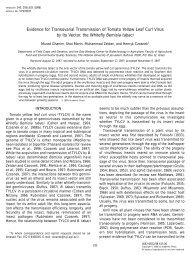10 Mali Talmor-Neiman et al.Figure 7. Experimental validation <strong>of</strong> predicted m<strong>RNA</strong> targets <strong>of</strong> mi<strong><strong>RNA</strong>s</strong>miR1215, miR1218, miR1221 <strong>and</strong> miR1223.(a) m<strong>RNA</strong> 756726571, (b) m<strong>RNA</strong> pphf2k14, (c) m<strong>RNA</strong> 824685933, (d) m<strong>RNA</strong>859476845. The m<strong><strong>RNA</strong>s</strong> cleavage sites were determined by modified <strong>RNA</strong>ligase-mediated 5¢-RACE. The mi<strong>RNA</strong> corresponding positions within the ORFor predicted untranslated regions (UTR) are indicated. The mi<strong>RNA</strong> sequences<strong>and</strong> partial sequence <strong>of</strong> the corresponding m<strong><strong>RNA</strong>s</strong> are shown. The arrowsindicate the positions <strong>of</strong> inferred cleavage sites <strong>and</strong> the numbers aboveindicate the fraction <strong>of</strong> cloned PCR products terminating at different positions.pre-mi<strong><strong>RNA</strong>s</strong> that possess stems larger then 42 nucleotides,including the mi<strong>RNA</strong>. The outcome <strong>of</strong> such a processing wasshown to be two 20–21-nucleotide small <strong><strong>RNA</strong>s</strong> designatedUL <strong>and</strong> LL (Kurihara <strong>and</strong> Watanabe, 2004). Pp_82, whichmapped to Pp-MIR1219a stem proximal to miR1219a, isreminiscent <strong>of</strong> such small <strong><strong>RNA</strong>s</strong>. Moreover, Pp-MIR1219astem is predicted to be 49 nucleotides long including themiR1219a (Figure 5). Thus, we conclude that a similar stepprobably occurs during the processing <strong>of</strong> MIR1219a. Wehave also found that small <strong><strong>RNA</strong>s</strong> Pp_112 <strong>and</strong> Pp_115 formedan mi<strong>RNA</strong>:mi<strong>RNA</strong>*-like duplex that mapped to Pp-MIR319dstem between Pp-miR319b:Pp-miR319b* <strong>and</strong> the loop structure(Figure 5b). This finding presents evidence <strong>of</strong> anunreported processing step <strong>of</strong> a plant pre-mi<strong>RNA</strong> stemfound between the mi<strong>RNA</strong>:mi<strong>RNA</strong>* <strong>and</strong> the loop structurethat is likely to be catalyzed by a DICER-like enzyme. Aninteresting question is whether this processing step occursafter or before the release <strong>of</strong> the mi<strong>RNA</strong>:mi<strong>RNA</strong>* duplex. Wepredict that such a cleavage step may occur in other premi<strong><strong>RNA</strong>s</strong>that have elongated double-str<strong>and</strong>ed stems upstream<strong>of</strong> mi<strong>RNA</strong>:mi<strong>RNA</strong>* duplex, because such a foldingtakes a typical structure <strong>of</strong> a DICER substrate. Interestingly,Li et al. (2005) found that Arabidopsis <strong>and</strong> rice pre-mi<strong><strong>RNA</strong>s</strong><strong>from</strong> the MIR319 <strong>and</strong> MIR159 families had have elongateddouble-str<strong>and</strong>ed stems that were atypically conserved inaddition to their mi<strong>RNA</strong>:mi<strong>RNA</strong>* region, which is typicallyconserved in most pre-mi<strong><strong>RNA</strong>s</strong>. They hypothesized thatsuch a conserved elongated stem might be a functionalsegment or might even encode for another mature mi<strong>RNA</strong>.The identification <strong>of</strong> the small <strong><strong>RNA</strong>s</strong> Pp_112 <strong>and</strong> Pp_115 <strong>and</strong>a putative target for Pp_115 supports such a hypothesis.Conversely, because Pp-MIR319d is predicted to encode PpmiR319b,which was the most abundant small <strong>RNA</strong> in ourlibrary (Arazi et al., 2005), we cannot exclude the possibilitythat Pp_112 <strong>and</strong> Pp_115 represent non-functional remnants<strong>from</strong> the processing <strong>of</strong> an abundant precursor.To date, targets <strong>of</strong> miR156 (Arazi et al., 2005), miR160(Axtell <strong>and</strong> Bartel, 2005) <strong>and</strong> miR166 (Floyd <strong>and</strong> Bowman,2004) have been validated in P. patens. The data presentedin this study raise the number <strong>of</strong> P. patens mi<strong>RNA</strong> validatedtargets to seven. Our target prediction suggests that, as inhigher plants (Zhang et al., 2006), the mi<strong><strong>RNA</strong>s</strong> in P. patensare involved in the regulation <strong>of</strong> a variety <strong>of</strong> gene families. Inspite <strong>of</strong> the specificity <strong>of</strong> corresponding mi<strong><strong>RNA</strong>s</strong> to mosses,several targets belong to gene families that have beenalready validated as mi<strong>RNA</strong> targets in flowering plants,highlighting the importance <strong>of</strong> mi<strong>RNA</strong> regulation for theproper function <strong>of</strong> these genes in plants. For instance, ourresults support that pphf2k14 <strong>and</strong> 859476845 putative NACdomaintranscription factors are genuine targets <strong>of</strong> miR1218<strong>and</strong> miR1223, respectively. In Arabidopsis, genes encodingNAC-domain transcription factors were demonstrated to beregulated by miR164 <strong>and</strong> this regulation was shown to berequired for organ separation (Laufs et al., 2004; Malloryet al., 2004) <strong>and</strong> lateral root development (Guo et al., 2005).miR1210 is predicted to target a gene that encodes an F-boxlikeprotein. Genes belonging to this class were validated asmiR393 <strong>and</strong> miR394 targets in Arabidopsis (Jones-Rhoades<strong>and</strong> Bartel, 2004). miR1217 is predicted to target a diseaseresistance-like protein, which might suggest a role for thismi<strong><strong>RNA</strong>s</strong> in a defense pathway in moss. In Populus, severaldisease resistance genes were validated as targets <strong>of</strong>miR482 (Lu et al., 2005).Interestingly, several targets belong to gene familiesthat, in flowering plants, do not include members thatare predicted to serve as mi<strong>RNA</strong> targets. miR1215 <strong>and</strong>miR1217 are predicted to target several phytochrome-likeª 2006 The AuthorsJournal compilation ª 2006 Blackwell Publishing Ltd, The Plant Journal, (2006), doi: 10.1111/j.1365-313X.2006.02768.x
<strong>Novel</strong> mi<strong><strong>RNA</strong>s</strong> <strong>and</strong> mi<strong>RNA</strong> <strong>biogenesis</strong> <strong>intermediates</strong> in moss 11proteins that contain a putative serine/threonine/tyrosinekinase domain in their C-termini. A homologous phytochrome(CpPHY1) has been characterized previously <strong>from</strong>the moss Ceratodon purpureus (Pasentsis et al., 1998;Thummler et al., 1992). The CpPHY1 recombinant C-terminaldomain was demonstrated to phosphorylate serine <strong>and</strong>threonine residues (Thummler et al., 1995). On the basis <strong>of</strong>its predicted structure it was suggested that it mightrepresent a soluble light sensor protein kinase that functionsin a cellular phosphorylating cascade (Thummler et al.,1992). In this regard our results support that 756726571,which is predicted to encode a putative kinase-like protein, isa genuine target <strong>of</strong> miR1215. Thus, there is a possibility thatboth targets <strong>of</strong> miR1215, a phytochrome-kinase <strong>and</strong> aprotein kinase, function in the same signal transductionpathway. In Arabidopsis, miR395 was demonstrated totarget three different genes all involved in the sulfurassimilation pathway (Bonnet et al., 2004a; Jones-Rhoades<strong>and</strong> Bartel, 2004). An m<strong>RNA</strong> product, consistent withmiR1221-mediated cleavage, has been detected by us for824685933 that encodes for a moss CRE1/WOL/AHK4 homolog.CRE1/WOL/AHK4 has been identified as a cytokininreceptor in Arabidopsis (Inoue et al., 2001). In P. patens,cytokinin stimulates the differentiation <strong>of</strong> a protonema-tipgrowing cell into a three-faced apical cell, the so-called bud,which later produces the leafy gametophore (Reski <strong>and</strong> Abel,1985). Our data indicate that miR1221 is relatively abundantin differentiated gametophores but almost absent <strong>from</strong>cytokinin responsive non-differentiated protonema. Fromthat we speculate that by clearing the m<strong>RNA</strong> that encodesfor a cytokinin receptor, miR1221 may reduce the response<strong>of</strong> a given gametophore cell to cytokinin.Finally, we have identified numerous genomic sequenceswith complementarity to the remaining identified mi<strong><strong>RNA</strong>s</strong>.However, since the P. patens genome is raw <strong>and</strong> notannotated, homology to known proteins was used as ameans <strong>of</strong> verifying their orientation. This constraint probablyprevented us <strong>from</strong> identifying many additional mi<strong>RNA</strong>targets, some <strong>of</strong> which probably encode for novel mossproteins. The anticipated annotation <strong>of</strong> the moss genomewill soon enable their identification. Such data will enrichour knowledge <strong>of</strong> the different functions <strong>of</strong> mi<strong><strong>RNA</strong>s</strong> in l<strong>and</strong>plants. Future functional studies <strong>of</strong> identified mi<strong><strong>RNA</strong>s</strong> <strong>and</strong>their targets are expected to be facilitated in P. patens inwhich efficient homologous recombination allows targetedgene disruption (Schaefer <strong>and</strong> Zryd, 1997).Experimental proceduresPlant material <strong>and</strong> culture conditionsProtonemata <strong>of</strong> P. patens subspecies patens (Ashton <strong>and</strong> Cove,1977) were cultured on a solid minimal medium described by Ashtonet al. (1979) supplemented with 2.7 mM NH 4 tartrate. Cultureswere grown in 9-cm Petri dishes on medium solidified with 0.7%agar (Merck 1614) <strong>and</strong> overlaid with 8-cm diameter cellophanedisks (type 325P; A. A. Packaging Limited, Preston, UK). Petri disheswere kept in a culture room at 24 1°C. Light was provided <strong>from</strong>above by two to four fluorescent tubes (Osram L 18W/10; Osram,Munich, Germany) under a regime <strong>of</strong> 16-h light/8-h darkness. Mossprotonema was subcultured every 7 days with a Polytron homogenizer(type PT 1600E; Kinematika, Lucerne, Switzerl<strong>and</strong>). Forisolation <strong>of</strong> adult gametophores, small pieces <strong>of</strong> 1-week-old healthyprotonemal tissue were inoculated for 45 days on solid minimalmedium in 9-cm diameter Petri dishes, under the above temperature<strong>and</strong> light conditions. Adult gametophores were then isolatedby cutting their stems a few millimeters above the agar withfine scissors.Nucleic acid isolationTotal <strong>RNA</strong> was extracted <strong>from</strong> protonemata or gametophores withTRI reagent (Sigma, Rehovot, Israel), according to the manufacturer’sprotocol, except that the upper phase containing the <strong>RNA</strong>was re-extracted two or three more times with 25:24:1 phenol:chlor<strong>of</strong>orm:isoamylalcohol to remove small-<strong>RNA</strong>-bindingproteins. After addition <strong>of</strong> isopropanol, the <strong>RNA</strong> extract wasincubated overnight at )20°C, instead <strong>of</strong> 5 min at room temperature,to enhance the precipitation <strong>of</strong> low-molecular-weight<strong><strong>RNA</strong>s</strong>. Following an ethanol wash, <strong>RNA</strong> was resuspended in 50%formamide (Sigma) <strong>and</strong> kept at )80°C until use. To prepare concentratedlow-molecular-weight <strong>RNA</strong> <strong>from</strong> 10-day-old protonema,500 lg <strong>of</strong> total protonema <strong>RNA</strong> was filtered through a Microcon-YM100 column (Millipore, Bedford, MA, USA) according to themanufacturer’s protocol. The low-molecular-weight <strong>RNA</strong> filtratewas then collected; ethanol precipitated <strong>and</strong> resuspended in 20 ll<strong>of</strong> 50% formamide.<strong>RNA</strong> gel blot analysisTotal <strong>RNA</strong> or low-molecular-weight <strong>RNA</strong> were resolved by electrophoresison denaturing 15% polyacrylamide gel containing 7 Murea in TBE buffer (45 mM Tris-borate, pH 8.0 <strong>and</strong> 1.0 mM EDTA),electroblotted to a Zeta-Prob membrane (Bio-Rad, Hercules, CA,USA) by means <strong>of</strong> a trans-blot transfer cell (Bio-Rad) for 1 h at500 mA. Following transformation, the membrane was UV crosslinked<strong>and</strong> dried overnight. Radiolabeled probes were made byend-labeling DNA oligonucleotides complementary to mi<strong><strong>RNA</strong>s</strong>equences with c 32 -ATP by means <strong>of</strong> T4 polynucleotide kinase(NEB). Blots were pre-hybridized <strong>and</strong> hybridized with EZ-hybridizationsolution (Biological Industries, Beit-Haemek, Israel).Hybridization was performed at 35–45°C overnight. Blots werewashed two to three times at 45–55°C with washing buffer(2 · SSC, 0.1% SDS) <strong>and</strong> autoradiographed using a phosphoimager(Fuji, Tokyo, Japan).Folding analysis <strong>and</strong> target predictionFoldback structures were predicted <strong>and</strong> their stability validated withthe MFOLD program (http://www.bioinfo.rpi.edu/applications/mfold/old/rna/form1.cgi) for default parameters (Zuker, 2003) <strong>and</strong> theRANDFOLD program for the 999 r<strong>and</strong>omizations <strong>and</strong> dinucleotideshuffling (Bonnet et al., 2004b). Stable foldback structures(0.005 ‡ P ‡ 0.001) were then selected only if they conformed to theconsensus properties <strong>of</strong> plant pre-mi<strong><strong>RNA</strong>s</strong> as formulated previouslyby Xie et al. (2005): (i) a minimum <strong>of</strong> 16 paired bases within theª 2006 The AuthorsJournal compilation ª 2006 Blackwell Publishing Ltd, The Plant Journal, (2006), doi: 10.1111/j.1365-313X.2006.02768.x
















